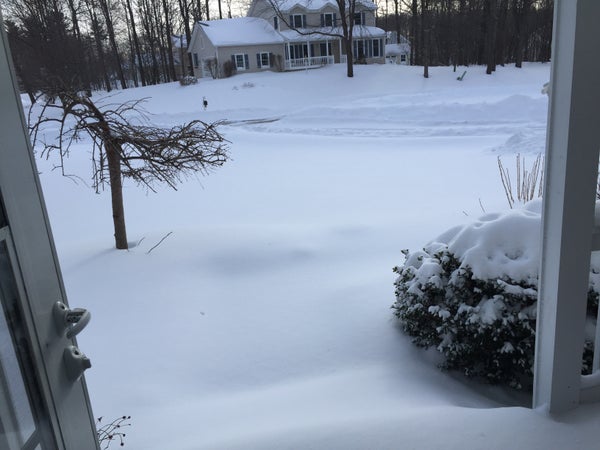This article was published in Scientific American’s former blog network and reflects the views of the author, not necessarily those of Scientific American
The snow and ice have arrived. And for a lot of the country that means the season of shoveling, salting, and suiting up before going outside. But rather than seeing all that extra effort as wasted, why not see it as a reason to get to know ice, salt, and snow a little bit better? If the winter break has your budding scientist itching for things to fill their time, consider this experiment as a break from the movies and hot chocolate.
Why do we salt the driveway?
A snowy lawn is a great excuse to build a fort, make a snowman, or wage a snow battle with the neighbors. Icy roads and driveways? Those are a lot less fun. Cities put a lot of work into trying to keep the roads clear enough that cars won’t keep going when they are supposed to stop, stay put when they are supposed to go, or run into things that they aren’t supposed to run into.
On supporting science journalism
If you're enjoying this article, consider supporting our award-winning journalism by subscribing. By purchasing a subscription you are helping to ensure the future of impactful stories about the discoveries and ideas shaping our world today.
But when you wake up in the morning to a snowy driveway, that’s up to you. Shovels and snow blowers take the obvious approach – they take the snow and put it somewhere else. But what about salting? Why do so many people cover their sidewalks and driveways with big grains of salt? With some paper bowls, a salt shaker, a measuring cup, and a stopwatch, you can find out.
Materials:
Marker
Table salt
6 paper bowls
½ cup measuring cup
½ tsp measuring spoon
Stopwatch
Paper
Pen or pencil
Freezer
Refrigerator
Access to snow (either from outside or made by whirring ice cubes in the blender)
What to do:
Get all of your materials ready before bringing the snow inside. You don’t want it to start melting too early.
Make sure there is space on the counter, in the freezer, and in the refrigerator to fit two bowls.
Use the marker to label the bowls in three pairs: 2 Counter, 2 Refrigerator, 2 Freezer. For each pair, label one as “Salt” and one as “No Salt.”
Use the measuring cup (or scale) to put the same amount of snow in each bowl.
Sprinkle each “salt” bowl with ½ tsp of salt, trying to spread it evenly over the surface of the snow.
Place the each set of bowls in their experimental location (on the counter, in the refrigerator, or in the freezer).
Start the stop watch.
Use your paper and pencil to make a table – one side keeping track of the location and condition (counter, counter salted, refrigerator, refrigerator salted, freezer, freezer salted) and the other providing spots to note when the snow starts to melt and when it is completely melted.
Quickly check the bowls every three minutes. If the snow in a bowl has started to melt, note the time in the table. Also note the time once the snow in a particular bowl seems to be completely melted.
Stop once the snow in all bowls has either completely melted or has stopped changing.
Now your budding scientist will have some bowls of water and a table of numbers to talk about. Rather than thinking that the experiment is over, it is time to have some discussions and see what the data they collected has to say. Depending on age, give some of the questions below a try.
Melting Times
Did adding salt seem to make the snow melt more quickly or more slowly?
For the bowls without any salt, how did the melting times compare between the three locations?
For the bowls with salt, how did the melting times compare between the three locations?
Did any of the bowls of snow stay frozen the whole time?
Do you think that salt will work when it is different temperatures outside?
Other Effects
Now look at the water in each of the bowls and imagine that you had to drink some. Which ones would you be willing to drink? Or use to feed the plants in your house?
Where do you think that the snow on your driveway goes after it melts?
If you had a vegetable garden along the edge of your driveway, when would you use salt instead of shoveling? When there is ice? When there is snow? Both?
What other solutions besides salt do you think cities could use to keep the roads safe in the winter?
